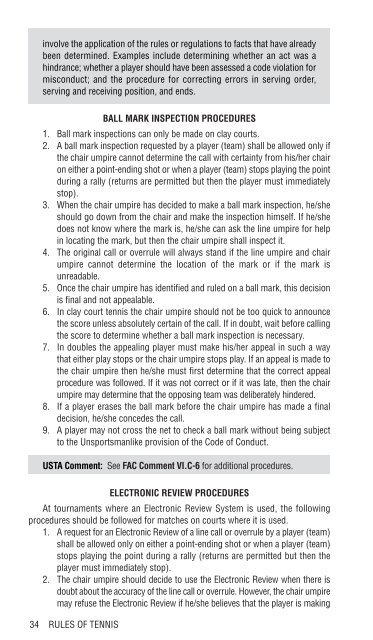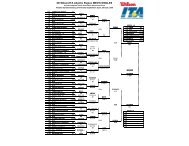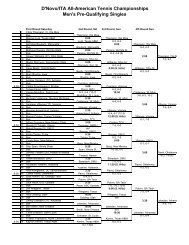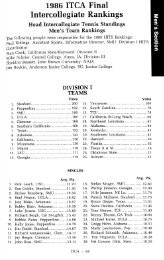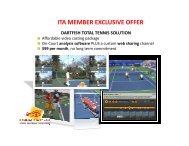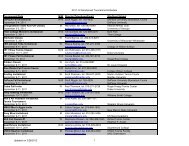Friend at Court - Intercollegiate Tennis Association
Friend at Court - Intercollegiate Tennis Association
Friend at Court - Intercollegiate Tennis Association
You also want an ePaper? Increase the reach of your titles
YUMPU automatically turns print PDFs into web optimized ePapers that Google loves.
involve the applic<strong>at</strong>ion of the rules or regul<strong>at</strong>ions to facts th<strong>at</strong> have already<br />
been determined. Examples include determining whether an act was a<br />
hindrance; whether a player should have been assessed a code viol<strong>at</strong>ion for<br />
misconduct; and the procedure for correcting errors in serving order,<br />
serving and receiving position, and ends.<br />
BALL MARK INSPECTION PROCEDURES<br />
1. Ball mark inspections can only be made on clay courts.<br />
2. A ball mark inspection requested by a player (team) shall be allowed only if<br />
the chair umpire cannot determine the call with certainty from his/her chair<br />
on either a point-ending shot or when a player (team) stops playing the point<br />
during a rally (returns are permitted but then the player must immedi<strong>at</strong>ely<br />
stop).<br />
3. When the chair umpire has decided to make a ball mark inspection, he/she<br />
should go down from the chair and make the inspection himself. If he/she<br />
does not know where the mark is, he/she can ask the line umpire for help<br />
in loc<strong>at</strong>ing the mark, but then the chair umpire shall inspect it.<br />
4. The original call or overrule will always stand if the line umpire and chair<br />
umpire cannot determine the loc<strong>at</strong>ion of the mark or if the mark is<br />
unreadable.<br />
5. Once the chair umpire has identified and ruled on a ball mark, this decision<br />
is final and not appealable.<br />
6. In clay court tennis the chair umpire should not be too quick to announce<br />
the score unless absolutely certain of the call. If in doubt, wait before calling<br />
the score to determine whether a ball mark inspection is necessary.<br />
7. In doubles the appealing player must make his/her appeal in such a way<br />
th<strong>at</strong> either play stops or the chair umpire stops play. If an appeal is made to<br />
the chair umpire then he/she must first determine th<strong>at</strong> the correct appeal<br />
procedure was followed. If it was not correct or if it was l<strong>at</strong>e, then the chair<br />
umpire may determine th<strong>at</strong> the opposing team was deliber<strong>at</strong>ely hindered.<br />
8. If a player erases the ball mark before the chair umpire has made a final<br />
decision, he/she concedes the call.<br />
9. A player may not cross the net to check a ball mark without being subject<br />
to the Unsportsmanlike provision of the Code of Conduct.<br />
USTA Comment: See FAC Comment VI.C-6 for additional procedures.<br />
ELECTRONIC REVIEW PROCEDURES<br />
At tournaments where an Electronic Review System is used, the following<br />
procedures should be followed for m<strong>at</strong>ches on courts where it is used.<br />
1. A request for an Electronic Review of a line call or overrule by a player (team)<br />
shall be allowed only on either a point-ending shot or when a player (team)<br />
stops playing the point during a rally (returns are permitted but then the<br />
player must immedi<strong>at</strong>ely stop).<br />
2. The chair umpire should decide to use the Electronic Review when there is<br />
doubt about the accuracy of the line call or overrule. However, the chair umpire<br />
may refuse the Electronic Review if he/she believes th<strong>at</strong> the player is making<br />
34 RULES OF TENNIS


